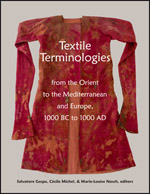Center, Textile Research

Textile Terminologies from the Orient to the Mediterranean and Europe, 1000 BC to 1000 AD
Date of this Version
2017
Document Type
Article
Citation
In Textile Terminologies from the Orient to the Mediterranean and Europe, 1000 BC to 1000 AD, ed. Salvatore Gaspa, Cécile Michel, & Marie-Louise Nosch (Lincoln, NE: Zea Books, 2017), pp. 122-152.
doi:10.13014/K2VM49F3
Abstract
Material culture data is mentioned in Talmudic (or ‘rabbinical’) literature when a relevant legal (‘halakhic’) or homiletic (‘midrashic’) context arises. Therefore, certain details may be lacking or ambiguously stated. This however is not presented in a systematic and detailed manner, such as in ‘Pliny’s Natural History’.2 Additional classical authors mention flax and linen. First and foremost: Diocletian3 in his edict of maximum prices. And in less scope and detail: Xenophon,4 Virgil,5 Strabo,6 Columella,7 Pausanias,8 and Theodosius II9 – in his codex. In some instances, these sources may be useful for comparison, contrast and clarification – to Talmudic sources. It is difficult to gauge the exact societal extent of the phenomena mentioned in this literature, however it may be assumed that they can be viewed as a representative sampling, or reliable cross-section of the material culture found in contemporaneous society in those periods (c. 2nd - 5th centuries AD) and regions (Land of Israel and Babylonia). This premise is unaffected by the academic disagreement which exists regarding the extent to which Talmudic laws were actually practiced by the general populace outside of the sphere of the Sages themselves. There is, however, academic consensus regarding those aspects of material culture which are described in this literature as reflecting Sitz im Leben. Historiography based upon Talmudic literature source material is a complex and challenging science. It will encompass aspects such as the use of various Aramaic dialects, the identities, backgrounds, times and locales of tradents10 and the legal and homiletic contexts in which the material culture data is presented. Nevertheless, these are outside of the scope of the current paper, which will focus strictly on material culture itself. The principal rabbinic works from which data is gleaned include: Mishna, Tosefta, Mekhilta, Sifra, Sifre,11 Jerusalem Talmud,12 Babylonian Talmud,13 Midrash Bereshit Rabba, Midrash Tanḥuma,14 and Aramaic ‘Targums’15 of the Pentateuch and Hebrew Bible. Each of these works embodies content originating in various periods, some of them long before the date of their respective final redactions. Pioneers in this field of Talmudic material culture research in general, and textiles specifically, were Gustav Dalman,16 R.J. Forbes,17 Abraham Herszberg,18 Samuel Krauss,19 and Saul Lieberman.20 Since then, our knowledge of Roman-era textiles has been greatly enhanced, due to research advances21 in the fields of archaeology, botany, iconography and philology. Notable among those whom have contributed to this field are Yehuda Feliks,22 John Peter Wild,23 Daniel Sperber, 24 Ze’ev Safrai,25 and Michael Sokoloff.26 All of the above will be accounted for in the current paper.
Included in
Ancient History, Greek and Roman through Late Antiquity Commons, Art and Materials Conservation Commons, Classical Archaeology and Art History Commons, Classical Literature and Philology Commons, Fiber, Textile, and Weaving Arts Commons, Indo-European Linguistics and Philology Commons, Jewish Studies Commons, Museum Studies Commons, Near Eastern Languages and Societies Commons, Other History of Art, Architecture, and Archaeology Commons


Comments
Copyright © 2017 Salvatore Gaspa, Cécile Michel, & Marie-Louise Nosch. Photographs copyright as noted.